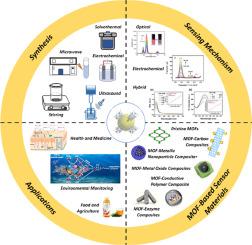The versatility of metal-organic frameworks-based biosensor for antioxidant detection
IF 3.7
Q1 CHEMISTRY, ANALYTICAL
引用次数: 0
Abstract
Antioxidants are crucial in mitigating oxidative stress caused by reactive oxygen and nitrogen species (ROS/RNS), contributing to chronic diseases and biomolecular damage. Beyond their biological significance, antioxidants are widely used in food, cosmetics, and pharmaceuticals to enhance stability and shelf life. Conventional detection methods—such as spectrophotometric assays (DPPH, ABTS, ORAC) and chromatographic techniques (HPLC, LC-MS)—are accurate but suffer from high costs, complex workflows, and limited portability. Biosensors offer a promising alternative, combining high sensitivity, rapid analysis, and real-time monitoring. Among these, metal-organic framework (MOFs) based biosensors stand out due to their tunable porosity, high surface area, and multifunctional design, enabling precise antioxidant detection via fluorescent, colorimetric, electrochemical, or hybrid mechanisms. These sensors achieve enhanced selectivity and signal amplification by integrating MOFs with various functional materials (e.g., graphene, gold nanoparticles (AuNPs)) or biomimetic catalysts (nanozymes), even in complex matrices like biological fluids or food extracts. However, challenges remain in improving commercial applications’ selectivity, stability, and scalability. This review examines MOF-based biosensing platforms, their design strategies, and detection mechanisms while addressing key obstacles in transitioning from lab-scale to real-world deployment. By highlighting recent advances and unmet needs, we aim to guide the development of next-generation biosensors for antioxidant monitoring in clinical, industrial, and environmental settings.

基于金属-有机框架的抗氧化剂检测生物传感器的多功能性
抗氧化剂在减轻由活性氧和氮物种(ROS/RNS)引起的氧化应激中起着至关重要的作用,有助于慢性疾病和生物分子损伤。除了其生物学意义外,抗氧化剂还广泛用于食品、化妆品和药品中,以提高稳定性和保质期。传统的检测方法,如分光光度法(DPPH, ABTS, ORAC)和色谱技术(HPLC, LC-MS),都是准确的,但成本高,工作流程复杂,便携性有限。生物传感器提供了一种很有前途的替代方案,结合了高灵敏度、快速分析和实时监测。其中,基于金属有机框架(mof)的生物传感器因其可调孔隙率、高表面积和多功能设计而脱颖而出,能够通过荧光、比色、电化学或混合机制进行精确的抗氧化剂检测。这些传感器通过将mof与各种功能材料(如石墨烯、金纳米颗粒(AuNPs))或仿生催化剂(纳米酶)集成,甚至在生物流体或食物提取物等复杂基质中,也能实现增强的选择性和信号放大。然而,在提高商业应用程序的选择性、稳定性和可伸缩性方面仍然存在挑战。本文综述了基于mof的生物传感平台,它们的设计策略和检测机制,同时解决了从实验室规模过渡到现实世界部署的关键障碍。通过强调最近的进展和未满足的需求,我们的目标是指导下一代生物传感器的发展,用于临床,工业和环境环境中的抗氧化剂监测。
本文章由计算机程序翻译,如有差异,请以英文原文为准。
求助全文
约1分钟内获得全文
求助全文

 求助内容:
求助内容: 应助结果提醒方式:
应助结果提醒方式:


